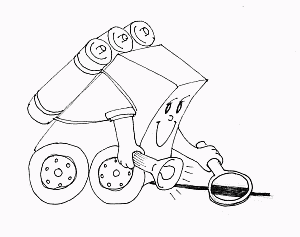This is an unofficial translation of the rules. The only official version of the rules in cases of misunderstanding is the Slovak version.

Linefollower
category
The competition task
To build a autonomous mobile robot, which will travel the whole defined path in a certain time. The direction and course is defined by the dark line, also some obstacles are presented.
The path
The background of the path will be white with dark (black) navigation line on it (width 15 +/- 1 mm). Total length of the path won't be more than 20 meters. Material used will be a chipboard.
The smallest radius of curves used in the path will be 5 cm Total rising of the path won't exceed 3 cm; maximal rising or declining is 5%. Like in the real life, there can be random obstacles in the path (interrupted navigation line, obstacle on the line, illumination changes and other).
The robot's task is not to find the right way, just to follow the navigation line.
The robot starts within the starting area, which is 30 cm before the start line (infrared beam of the time measuring device). When the beam is interrupted by any part of the robot, the time starts to be measured.
The time measurement is stopped when the similar beam of light located at the end of the path is interrupted.
There are no barriers at the edge of the contest area. On the each side of the dark line will be the 15 cm wide safety area. Nevertheless, it is recommended to implement the safety device to avoid the fall from the edge. Organizers can not guarantee that area around the arena will be open. Hence the authors used to carefully evaluate the sensor measurements, especially near the arena edges.
Obstacles
The path may contain various obstacles in various order. There is no guarancy that all of them will be present. Some of them may be presented more than once.
- P1: There can be a tunnel in the path (of minimal dimension 20 x 20 cm).
Example...
- P2: Black course line can be anywhere interrupted (max. 7 cm)
Example...
- P3: There can be a reflector shining on the path.
Example...
- P4: The line can be forked on certain place, whereas the length of the both segments is not necessarly the same.
Example...
- P5: There can be a bridge on the path (max. height 10 cm)
Example...
- P6: Anywhere can be placed the obstacle brick. This obstacle used to be
avoided. The robot has to return to the black line max. 30 cm
after the brick.
Example...
- P7:
On any place, the track can change its color to the red, blue
or green one. Length of the colour segment will be not longer
than 15 cm.
Example... - P8:
There can be a curtain type obstacle on the track. It is possible to
drive through it or avoid it to continue the tour.
Example... - P9:
On any place, there can occur an "oil spoil" on the track.
Moreover, the track can change its direction under the spoil.
Example... - P10:
At the end of the track there will be a return loop to return the robot
back to the track in reverse direction.
Example...
Robot operation
There must not be any interference between the robot and its team after the robot is set in the starting circle and turned on. The robot must be controlled only by its electronics.
The robot may not leave the line after crossing the starting line. Avoiding obstacles is the only one exception. While moving, the robot may not leave any marks or beacons on the table. No parts can remain on the path during the run.
The competitor is disqualified when the competition path is damaged.
Dimensions and size of the robot
The width and height of the robot cannot exceed 20 cm. Length of the robot is not limited. Please, notify the limits given by tunnels and circle radiuses during the run.
Minimal dimensions and weight are not limited.
The competition and the order of the competitors
Order of the competitors is based on the results of homologization. During the homologization robot has to show its ability to drive the track with three simple obstacles P1, P2 and P3 (tunnel, reflector and interruption). The competitors must be prepared to the start within 1 minute after the call. Every robot has total 3 runs to compete. But if the competitor does not present within 1 minute after the call, the run is lost. The time between the runs can be used for fixing and adjusting the robot. In the case of too many competitors, the jury can decrease the number of runs, or it can proclaim a qualifying round.
Time limits
The robot has 3 minutes to complete the path. After 3 minutes, the time measurement is stopped and the run is canceled. But the robot is not disqualified. The time stop has no affect on the next runs.
Evaluation and prices
In the 2017 the levels are canceled, each robot compete in the same competition. On the other hand, there is a compulsory homologization added. Each robot, after the succesfull homologization obtains a small price. The robot has to travel all the track, turn at the end and safely return home.
The winner is the robot with the shortest time from any of the three runs. Unfinished run will not be evaluated.
The jury can also award the robot with the best design or interesting construction. And, of course, all the common rules apply.
FAQ
- "travel all the track, turn at the end and safely return home" - this applies also on fork (P4) - has the robot use the same fork? No, this is not necessary.